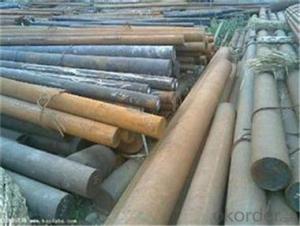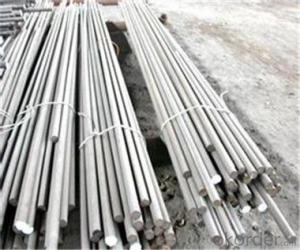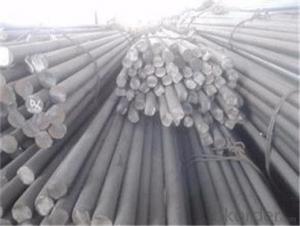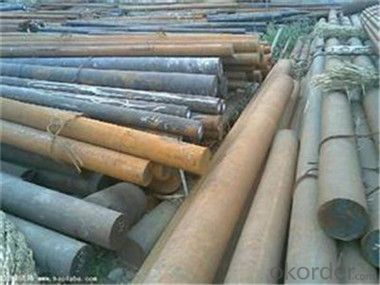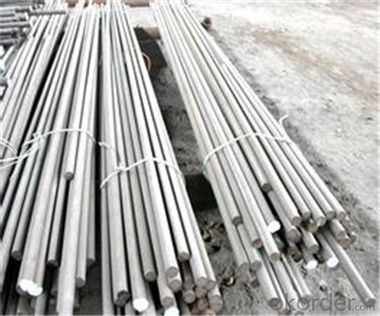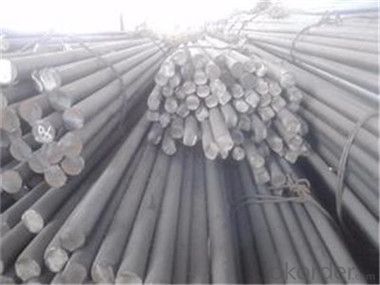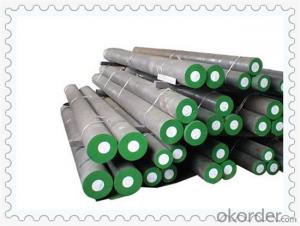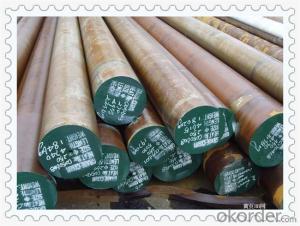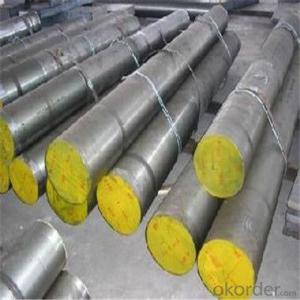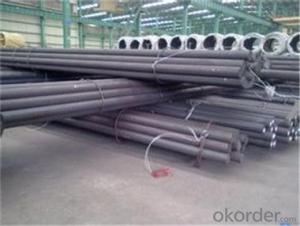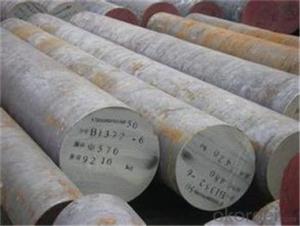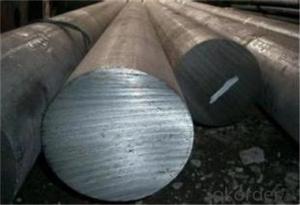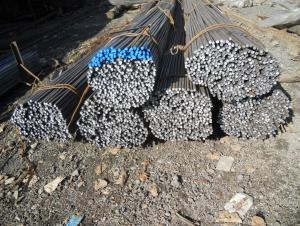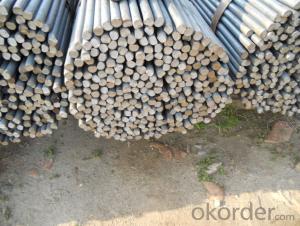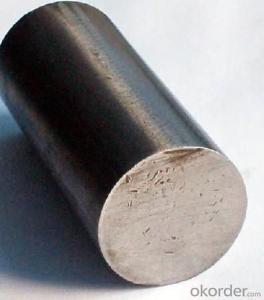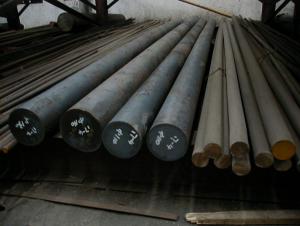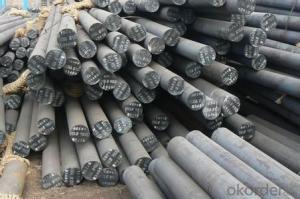HSS Steel Round Bar/High Alloy Round Tool Steel Bar/M2/M25M42/D2
- Loading Port:
- Tianjin
- Payment Terms:
- TT OR LC
- Min Order Qty:
- 77 m.t.
- Supply Capability:
- 2000000 m.t./month
OKorder Service Pledge
OKorder Financial Service
You Might Also Like
Description of steel round bar:
Characteristic:Tungsten-molybdenum high speed steel developed by China,high performance in toughness ,hardness, high temperature hardness.Carbon steel rod applies to chemical industry, shipping industry,manufacturing industry,construction,decorate Industry,electric power,pump shafts, sanitary wares,furniture handles,boiler,high temperature resistant,low temperature resistant, corrosion resistant.
Festures of steel round bar:
Anneal temperature: 840-860
Relief annealing temperature: 720-760
Hardening temperature: 1210-1230
Hardening medium: salt bath under 600,aslo use oil cooling or air cooling
Specifications of steel round bar:
| C | Si | Mn | W | Mo | Cr | V | P | S |
| 0.80-0.90 | 0.20-0.45 | 0.15-0.40 | 5.50-6.75 | 4.50-5.50 | 3.80-4.40 | 1.75-2.20 | ≤0.030 | ≤0.030 |
Images of steel round bar:
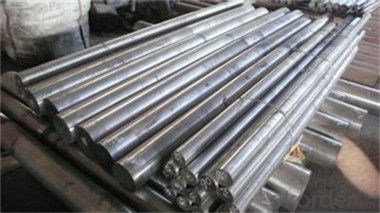
FAQ:
1. What is your package?
Packing situation: standard seaworthy packing or as customer required.
2. How long is the lead time?
Delivery time: 45 days after order confirmed.
3. What payment term do you accept?
Payment: T/T or L/C at sight.
- Q: Can steel round bars be used for making hydraulic systems?
- No, steel round bars are not suitable for making hydraulic systems as they lack the necessary properties like corrosion resistance and flexibility required for hydraulic applications.
- Q: What are the environmental considerations of steel round bars?
- Steel round bars pose several environmental considerations. Firstly, the extraction of iron ore, which is necessary for steel production, can have adverse effects on ecosystems and habitats. The mining process can cause deforestation, soil erosion, and the release of harmful pollutants into the air and water. In addition, manufacturing steel round bars requires a substantial amount of energy, often derived from non-renewable sources like coal and natural gas. The combustion of fossil fuels for energy contributes to greenhouse gas emissions and climate change. The steel industry is a major global emitter of carbon dioxide. Furthermore, the transportation of steel round bars also has environmental consequences. When steel products are shipped over long distances, it contributes to carbon emissions and air pollution. This is particularly significant when steel is imported or exported over vast distances. However, it is crucial to acknowledge that steel is a highly recyclable material. By recycling steel, the need for new production is reduced, energy is conserved, and the environmental impacts related to mining and extraction are decreased. By opting for steel round bars made from recycled steel, individuals and industries can contribute to a more sustainable and environmentally-friendly approach. In summary, the environmental considerations of steel round bars encompass the impacts of mining and extraction, energy consumption during production, and transportation emissions. Nevertheless, the recyclability of steel presents an opportunity to mitigate these environmental impacts and foster a more sustainable steel industry.
- Q: Can steel round bars be coated for improved aesthetics?
- Indeed, steel round bars have the potential to be coated for enhanced aesthetics. By applying a coating to steel round bars, their appearance can be elevated, resulting in a sleeker and more visually pleasing surface. Multiple coating alternatives, such as powder coating, electroplating, or painting, can be utilized to achieve diverse aesthetic outcomes when coating steel round bars. Moreover, these coatings offer more than just an improved appearance; they also grant additional advantages like increased resistance to corrosion and heightened durability. As a result, the practice of coating steel round bars is widely employed across various domains, including architecture, decoration, and industry, to enhance their aesthetics.
- Q: Do you need paint for roof lightning proof steel bars?
- If the metal surface is coated with a thick layer of insulating paint, it will seriously affect the flashover effect. In the national standard, the metal roof is directly used as a flash receiver. The thickness of the paint used on the roof must be less than the required value. That is what it means.
- Q: How do steel round bars perform in low-temperature environments?
- Steel round bars generally perform well in low-temperature environments. The mechanical properties of steel, such as strength and toughness, are typically maintained at low temperatures. However, it is important to consider the specific grade of steel being used, as some grades may exhibit reduced impact resistance or brittleness at extremely low temperatures. One common concern is the potential for brittle fracture in steel round bars at low temperatures. This can occur when the steel transitions from a ductile to a brittle state. However, most standard steel grades used in construction and industry are designed to resist brittle fracture even in low-temperature environments. Certain special alloy steels, such as low-temperature carbon steels, are specifically formulated to provide superior performance in extremely cold conditions. These steels contain additional elements, such as nickel or manganese, which enhance their low-temperature properties. They are often used in applications that require excellent toughness and impact resistance, such as offshore structures or cryogenic storage tanks. In summary, steel round bars generally perform well in low-temperature environments, and their mechanical properties are typically maintained. However, it is important to select the appropriate steel grade for the specific low-temperature application to ensure optimal performance and prevent potential issues such as brittle fracture.
- Q: Can steel round bars be used in the manufacturing of office furniture?
- Yes, steel round bars can be used in the manufacturing of office furniture. Steel is a versatile and durable material that can be shaped into various forms, including round bars. These round bars can be used as structural components in office furniture, such as table legs, chair frames, or support beams. Steel round bars provide strength and stability to the furniture, making it suitable for heavy use in office environments. Additionally, steel can be finished in different ways, such as powder coating or chrome plating, to enhance its appearance and match the aesthetic of the office space. Overall, using steel round bars in the manufacturing of office furniture offers durability, stability, and a modern look.
- Q: How do steel round bars compare to stainless steel round bars?
- Steel round bars and stainless steel round bars have some key differences that make them suitable for different applications. One of the main differences between steel and stainless steel round bars is their composition. Steel is primarily made of iron, with small amounts of carbon and other elements. Stainless steel, on the other hand, is an alloy composed of iron, chromium, and often other elements like nickel or molybdenum. This composition gives stainless steel its unique properties, such as corrosion resistance. In terms of strength, both steel and stainless steel round bars can be manufactured to have high tensile strength. However, stainless steel generally has higher tensile strength compared to regular steel, making it more suitable for applications that require additional strength and durability. Another important difference is their resistance to corrosion. Stainless steel round bars have excellent corrosion resistance due to the presence of chromium in their composition. This makes them ideal for applications where they will be exposed to moisture, chemicals, or other corrosive environments. Steel round bars, on the other hand, are more susceptible to rust and corrosion and may require additional protective coatings in such environments. In terms of cost, steel round bars are generally more affordable compared to stainless steel round bars. The higher cost of stainless steel is due to its unique properties and the additional alloying elements required in its production. Both steel and stainless steel round bars have their own advantages and applications. Steel round bars are commonly used in construction, manufacturing, and general-purpose applications where corrosion resistance is not a primary concern. Stainless steel round bars, on the other hand, find extensive use in industries such as food processing, chemical processing, medical equipment, and marine applications, where corrosion resistance is crucial. In summary, the choice between steel round bars and stainless steel round bars depends on the specific requirements of the application. Steel round bars are more affordable but may require additional corrosion protection, while stainless steel round bars offer superior corrosion resistance and strength.
- Q: What is the maximum molybdenum content allowed for steel round bars?
- The maximum molybdenum content allowed for steel round bars varies depending on the specific steel grade and industry standards. However, in general, the maximum molybdenum content in steel round bars is typically around 0.5% to 1.5% by weight.
- Q: What is the maximum titanium content allowed for steel round bars?
- The maximum titanium content allowed for steel round bars typically depends on the specific steel grade and composition. However, as a general guideline, the maximum titanium content in steel round bars is usually around 0.05-0.06%.
- Q: What are the advantages of using heat-resistant steel round bars?
- Heat-resistant steel round bars have several advantages. Firstly, they are designed specifically to maintain their mechanical properties even in high temperatures. This means they can remain strong and structurally sound in extreme heat conditions. Secondly, these round bars have exceptional resistance to corrosion. This makes them highly durable and suitable for environments where they may come into contact with corrosive substances or chemicals. Their resistance to corrosion ensures a longer lifespan and reduces the need for frequent maintenance or replacement. Additionally, heat-resistant steel round bars have superior thermal conductivity. This allows them to efficiently transfer heat, which is beneficial in industries like power generation or petrochemicals where heat transfer is crucial. Using heat-resistant steel round bars guarantees optimal performance and energy efficiency. Furthermore, these round bars offer excellent dimensional stability. Even when exposed to high temperatures, they retain their shape and size without warping or deforming. This is particularly important in applications that require precise measurements and tight tolerances. Lastly, heat-resistant steel round bars come in various sizes and grades, offering versatility in their applications. They can be used in industries such as aerospace, automotive, construction, and manufacturing, where high temperatures are involved. In conclusion, the advantages of using heat-resistant steel round bars include their ability to withstand high temperatures, resistance to corrosion, superior thermal conductivity, dimensional stability, and versatility in applications. These benefits make them an ideal choice for industries that require materials to perform reliably under extreme heat conditions.
Send your message to us
HSS Steel Round Bar/High Alloy Round Tool Steel Bar/M2/M25M42/D2
- Loading Port:
- Tianjin
- Payment Terms:
- TT OR LC
- Min Order Qty:
- 77 m.t.
- Supply Capability:
- 2000000 m.t./month
OKorder Service Pledge
OKorder Financial Service
Similar products
Hot products
Hot Searches
Related keywords
